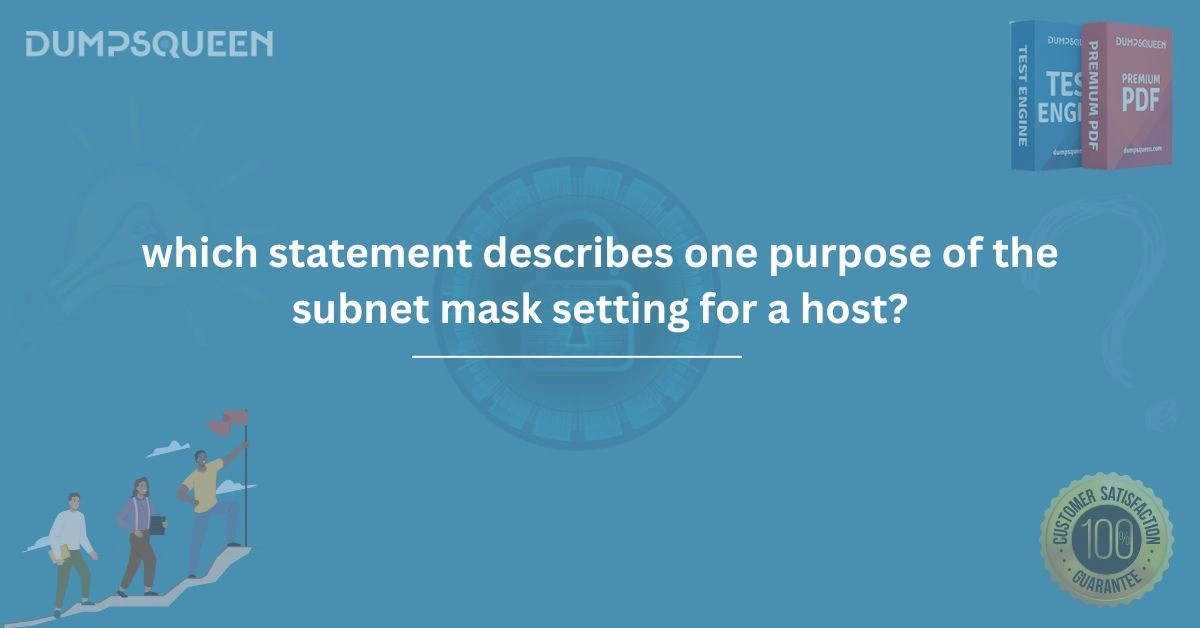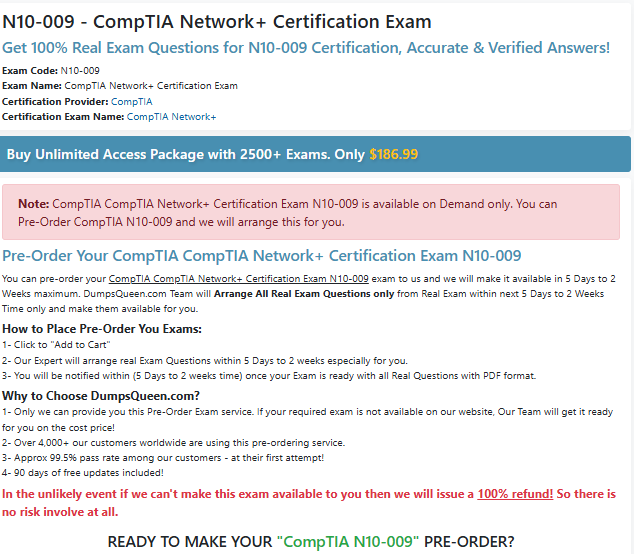Introduction
Understanding how devices communicate within a network is a fundamental aspect of networking, whether you're preparing for a certification like Cisco's CCNA or simply expanding your IT knowledge. One of the most crucial components in IP networking is the subnet mask. This seemingly simple numerical value plays a pivotal role in how devices determine whether they can communicate directly with each other or must route traffic through a gateway. The question "in which statement describes one purpose of the subnet mask setting for a host?" is a frequently asked one in many certification exams. It is especially common in the context of exams related to CompTIA, Cisco, and other foundational networking credentials. DumpsQueen, as a leading platform for certification preparation, frequently receives inquiries about this core concept from aspiring network engineers and IT professionals. This article aims to demystify the subnet mask by exploring its function, how it affects networking behavior, and why understanding it is crucial for exam success.
What Is a Subnet Mask?
A subnet mask is a 32-bit number that divides an IP address into two parts: the network portion and the host portion. It accompanies every IP address to define the boundary between what is the network address and what is the host address within that network. The most common representation of a subnet mask looks like this: 255.255.255.0. This decimal format is a human-readable version of a binary string. While the IP address tells us where a device is located, the subnet mask tells the system what part of the address specifies the network and what part can be used to identify individual hosts. Without the subnet mask, a device wouldn't know whether the destination IP it wants to communicate with is within its local network or in a different one.
The Role of the Subnet Mask in Host Communication
When a host device receives an IP address configuration (manually or via DHCP), it also receives a corresponding subnet mask. The subnet mask helps the host determine if another IP address is part of the same local network or if the data must be sent to a router (gateway) for delivery outside the network. This distinction directly affects communication efficiency. For example, if Host A with IP 192.168.1.10 and subnet mask 255.255.255.0 tries to communicate with Host B at 192.168.1.20, it compares the network portions of both addresses using the subnet mask. Since both fall within the same network range (192.168.1.0/24), they can communicate directly. But if Host B’s IP were 192.168.2.20, then the traffic must be sent to the router. Therefore, the most accurate response to the question “in which statement describes one purpose of the subnet mask setting for a host?” is: “It determines which part of an IP address identifies the network and which part identifies the host.”
Subnetting and Network Segmentation
Subnetting is the practice of dividing a large network into smaller, more manageable segments, or subnets. This is primarily done using subnet masks. By customizing subnet masks, network administrators can control the number of devices in each subnet, optimize performance, and enhance security. For example, a Class C IP range (192.168.1.0) typically comes with a default subnet mask of 255.255.255.0, allowing for up to 254 usable host addresses. But if you needed to create two subnets from this range, you could use a subnet mask of 255.255.255.128, splitting the available addresses into two groups. This technique is vital in enterprise environments, especially for segmenting departments, reducing broadcast traffic, and maintaining structured IP address schemes. DumpsQueen encourages certification aspirants to deeply understand subnetting concepts, as they form the backbone of many networking certification exam questions.
How Subnet Masks Aid in Routing Decisions
When a host wants to send data to another IP address, the first step is to determine whether that IP address is in the same subnet. The host does this by applying its subnet mask to both its own IP address and the destination IP address. If the resulting network addresses match, the destination is local. Otherwise, the host sends the data to its configured default gateway, which then forwards the data toward its destination. This decision-making process is impossible without a subnet mask. The gateway, switches, and routers all rely on subnet mask information to properly route traffic across complex networks. Without the subnet mask, a host would be incapable of understanding its local context and would treat all addresses equally leading to inefficient communication and routing errors.
Subnet Masks in IP Classes and CIDR
Originally, IP addresses were assigned based on classes: A, B, C, D, and E. Each class had a default subnet mask:
-
Class A:
255.0.0.0 -
Class B:
255.255.0.0 -
Class C:
255.255.255.0
However, this classful system proved inflexible, which led to the introduction of Classless Inter-Domain Routing (CIDR). CIDR uses notation like /24, /16, or /28 to define subnet masks, allowing much more granular network design. For instance, 192.168.1.0/24 means a subnet mask of 255.255.255.0. CIDR notation is now standard in modern networking and is especially emphasized in current certifications. Understanding how a subnet mask works within CIDR and how it affects IP address allocation is a critical skill for any networking professional. DumpsQueen offers resources and dumps that include practice questions about CIDR, classful addressing, and subnet masks to ensure users are exam-ready.
Real-World Examples of Subnet Mask Usage
Imagine an office environment with three departments: HR, IT, and Finance. Each department needs to operate on its own subnet to prevent broadcast traffic from crossing departmental lines. The IT administrator can use different subnet masks to assign smaller network ranges to each group. For example:
-
HR:
192.168.10.0/26 -
IT:
192.168.10.64/26 -
Finance:
192.168.10.128/26
Using the subnet mask 255.255.255.192, each subnet supports 62 hosts, which is sufficient for most department sizes. This setup not only optimizes network efficiency but also adds a layer of organizational control.
Importance in Exam Preparation
If you're preparing for certifications such as Cisco CCNA (200-301), CompTIA Network+, or Microsoft’s networking modules, understanding subnet masks is a guaranteed requirement. Many practice exams, including those provided by DumpsQueen, contain questions directly derived from the behavior and configuration of subnet masks. Being able to determine network and host addresses, calculate usable IP ranges, and troubleshoot communication issues based on subnet masks is vital. Candidates must also be comfortable with binary math, CIDR conversion, and address planning.
Free Sample Questions
Q1: In which statement describes one purpose of the subnet mask setting for a host?
A. It identifies the physical address of the network interface.
B. It enables DHCP functionality.
C. It determines the gateway address.
D. It defines the network and host portion of an IP address.
Correct Answer: D
Q2: What is the result of applying the subnet mask 255.255.255.0 to the IP address 192.168.5.23?
A. Host is part of the 192.168.5.0 network
B. Host is part of the 192.168.0.0 network
C. Host cannot communicate with other devices
D. Host is using an invalid IP address
Correct Answer: A
Q3: Which subnet mask would allow 6 usable hosts per subnet?
A. 255.255.255.248
B. 255.255.255.240
C. 255.255.255.224
D. 255.255.255.255
Correct Answer: A
Q4: Which of the following best describes the purpose of a subnet mask in IPv4?
A. It acts as a backup IP address.
B. It identifies broadcast domains.
C. It determines if an address is within the local subnet.
D. It enables NAT translation.
Correct Answer: C
Conclusion
The question "in which statement describes one purpose of the subnet mask setting for a host?" is not only a common one in exams, but also a fundamental concept that underpins modern IP networking. A subnet mask helps a host decide whether the destination IP is part of its own subnet or not. This simple yet powerful mechanism enables efficient data routing, controlled network segmentation, and logical addressing. Whether you are studying for your first networking exam or brushing up on your skills for a job interview, subnet masks are a topic you must thoroughly understand. At DumpsQueen, we recognize the importance of mastering these foundational topics. That’s why our expertly curated dumps and study resources include comprehensive coverage of subnetting, subnet masks, and related protocols all designed to give you the confidence to succeed in your certification journey.




